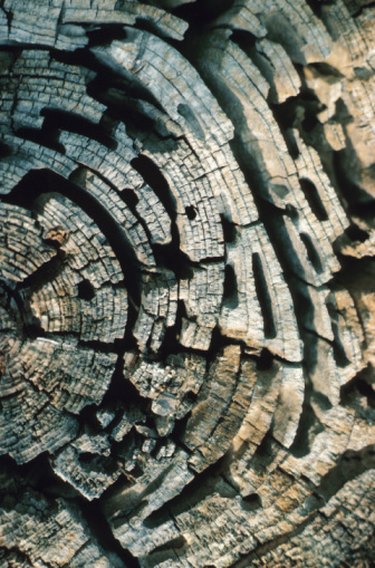
Contrary to popular belief ants don't eat wood but they do burrow into it to make nests. Whether they're eating it or not the damage they do to wood can compromise the structure of trees or homes. Knowing how to spot an infestation early on and knowing how to control wood-nesting ants can help save your house or even the trees around your home.
Common Carpenter Ants
Video of the Day
The most common wood-nesting ants are called carpenter ants and come from the genus Camponotus. According to the University of California, two of the most destructive species are C. modoc, the western black carpenter ant, and C. vicinus. The western black carpenter ant is uniformly black in color while C. vicinus is typically red and black.
Video of the Day
A third problem ant is C. clarithorax. This ant is smaller than the other two and is typically yellow and black. All three are found primarily in the western part of the United States. Carpenter ants are widespread throughout North America and the Natural History of North America website lists 51 separate species. If you suspect you have carpenter ants contacting an exterminator or the entomologists at your local university could help identify which species is the culprit.
Colony and Life Cycle
Carpenter ants are omnivorous and will eat other insects, nectar or even the honeydew excreted by nectar-feeding insects. They enter houses in search of nesting sites or moisture and can set up colonies of thousands of ants. Indoor sites are usually satellites of central nests located outdoors in trees, woodpiles or landscaping material. Several satellite nests can be associated with one parent nest and each nest can have its own queen. Reproductive males have wings and fly to find a queen. They die after mating and the inseminated queen goes on the hunt for a nest site. Once she finds one it can take years for a large colony to form.
Nesting Sites and Damage
Carpenter ants have large jaws for chewing through wood. According to entomologists at Texas A&M they prefer moist or rotted wood. As they create their nests they chew through wood, creating tunnels and galleries connecting tunnels. These tunnels and galleries are smooth and look as though they've been sanded. You can often locate nests by looking for wood scrapings around exit holes. These scrapings are coarser than construction sawdust. Though damage is usually not extensive, since the ants don't eat the wood, the nests can occasionally threaten the structural integrity of trees and homes.
Control
Entomologists from Washington State University insist that you must treat all colonies on or around a property to quell an infestation. They state that the only permanent solution is to locate and eradicate the parent nest and all satellite nests. Unfortunately pesticide application is the only method known to kill carpenter ants. You may want to contact a professional for assistance.
Prevention is always the best cure so trim trees and shrubs to keep them away from structures. Seal off possible entry points and reduce mulch depth around structures to between two and three inches. Keep soil away from wooden structures and increase ventilation to attics and garages to prevent moisture and decay. Keep potential food sources in tightly-sealed containers.